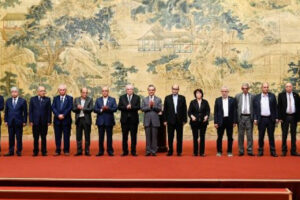The Saudi Fashion Commission has revealed that the local fashion industry has the largest projected growth rates of any other large, high-income market.
This follows the commission’s “The State of Fashion in the Kingdom of Saudi Arabia” report, which was released in June and recently showcased at a forum in Riyadh.
The forum delved into the significance of the report’s data and findings. For example, in 2022 the Kingdom’s fashion sector made a substantial impact on the domestic economy, contributing a noteworthy 1.4 percent to the nation’s gross domestic product. This amounted to an impressive $12.5 billion, highlighting the industry’s integral role in driving economic growth and diversification.
From 2021 to 2025, fashion sales in Saudi Arabia are expected to surge by 48 percent, representing an annual growth rate of 13 percent, according to the report.
“The young generation, their excitement about creativity, and the positive outlook on economic growth in the country is driving more and more businesses to be creative,” Burak Cakmak, CEO of the commission, told Arab News.
“We also already see a big interest from international brands to be part of this growth and their drive, also to open more stores, hire more executives, and create a lot more buzz and interest in the country.”
The report was launched in the form of a book in which the pages can be stitched into an elegant evening gown. The sustainable and innovative creation was designed by Saudi fashion house Atelier Hekayat, which said it wanted “a book that can be worn and a dress that can be read.”
Before the report, existing data was generalized across all sectors, such as consumer goods or overall spending, but specific fashion categories did not exist. While the industry’s potential was there, it was not officially documented in numbers. This drove the commission to initiate an annual report to showcase the local industry as a resource for domestic and international investors and businesses.
To compile the report, the commission relied on existing governmental systems.
“The beauty of being in the fashion commission is that we have access to our network, through the Ministry (of Culture), to this information, and also qualitative to quantitative data that we’re already collecting, because we’re engaged with the whole industry across the value chain,” Cakmak said.
“We’re working not only with small brands, but also retailers (to be) able to work across that full value chain to get both quantitative data and information through focus groups and research that really enabled us to put this together this year. We’re looking forward to building on it and making it even more detailed and interesting.”
Of the significance of the sector’s projected growth, Cakmak added: “The most surprising (thing), although I knew that there was growth expected, is that we’re looking at a 13 percent growth by 2026. This is an up to $32 billion turnover in terms of the size of the sector, which was quite unexpected.”
Shedding light on the sector’s impressive contribution to job creation, the report highlights that in 2022, employees engaged in fashion-related roles reached 230,000. This included 90,000 jobs in core fashion occupations dedicated to supporting the industry, and an additional 140,000 jobs in non-core and ancillary roles that contributed to the sector’s vitality.
At the heart of Saudi fashion’s growth was the commission’s resolute inclusivity push, seen in a dedicated program boosting women’s employment. This resulted in women making up 52 percent of employees in Saudi Arabia’s fashion sector, which aligns with the broader goal of promoting gender equality.
“The number of spaces that are opening up, the number of people who are going to be working in the sector, and the local brands’ desire to rebuild much larger businesses are going to drive a lot of growth,” Cakmak said, adding that roles such as retail sales workers, managers and designers would enjoy particular growth.
The report suggests that the development of new malls and shopping plazas across the country indicates the prosperity of physical store locations.
As e-commerce also proves to be valuable, sitting at 9 percent of total retail sales across the country, it also paves the way for emerging designers to significantly disrupt the market.
The report also documents fundamental insights across various factors, such as the fashion industry’s top import sourcing, the growth of various fashion categories, government expenditure and manufacturing.
The Kingdom’s initiatives towards sustainability practices do not end at fashion.
Prospects of greener ecosystems, innovations in garment manufacturing and fabric production, and integration of material advancement technologies were also highlighted in the report.
As the country is attracting international investors and interest, the report aims to be an essential document for key stakeholders in Saudi fashion. It also aims to help them to review and assess their operations in the country.
“It’s a way to benchmark and measure their progress,” Cakmak said. “Beyond that, also to be able to highlight opportunities for investment and partnerships in the country for international companies and brands (is vital). Because until now, they didn’t have the data; they’re only relying on their existing customer data most of the time through licensing and franchising deals. It’s not necessarily giving the full picture to some of the international players.”
The commission has also helped showcase local creatives and designers to the rest of the world through the Saudi 100 Brands initiative. Its participants have gained opportunities to show internationally at Paris and Milan fashion weeks.
“The fact that we’re showing this kind of growth already is a high-level indicator of how fashion contributes to the overall economy of the country, which actually is a topic that’s relevant to everybody who is living in Saudi Arabia,” Cakmak said.
“There’s a lot of interest, especially from the young generation, to building businesses. The entrepreneurial ambition of Saudis, and confidence in the future of the country’s growth, is driving people to take a piece of that economic growth, and contribute to it, and also build their businesses.”















